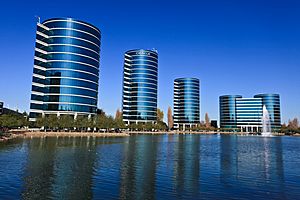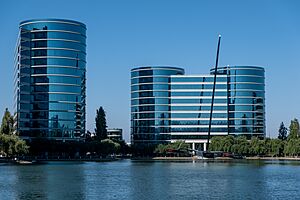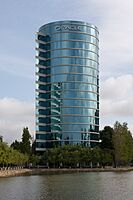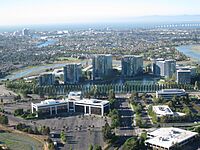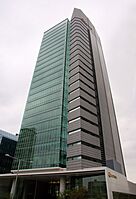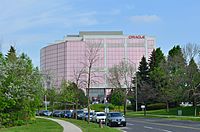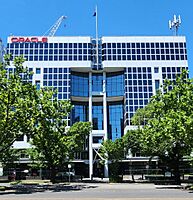Oracle Corporation facts for kids
| Public | |
| Traded as | |
| ISIN | [https://isin.toolforge.org/?language=en&isin=US68389X1054 US68389X1054] |
| Industry |
|
| Founded | June 16, 1977, in Santa Clara, California, United States |
| Founders |
|
| Headquarters |
,
United States
30°14′34″N 97°43′18″W / 30.2428699°N 97.7216941°W |
|
Area served
|
Worldwide |
|
Key people
|
|
| Products |
|
| Revenue | |
|
Operating income
|
|
| Total assets | |
| Total equity | |
| Owner | Larry Ellison (42.7%) |
|
Number of employees
|
c. 162,000 (2025) |
| Subsidiaries | List of Oracle subsidiaries |
| Footnotes / references Financials as of May 31, 2025[update]. |
|
Oracle Corporation is a big American technology company. It makes and sells computer software and hardware. Oracle is based in Austin, Texas, and was started in 1977 by Larry Ellison, Bob Miner, and Ed Oates.
Oracle is one of the largest software companies in the world. It creates special software for businesses, like programs for managing finances, human resources, and customer information. Oracle is also a leader in cloud computing, which means it provides computer services over the internet.
Contents
Oracle's Journey: A Look at Its History
Oracle started in 1977 in Santa Clara, California. It was first called Software Development Laboratories (SDL). The founders, Larry Ellison, Bob Miner, and Ed Oates, were inspired by a paper about how to manage large amounts of data. They wanted to create a new kind of database system.
In 1979, the company changed its name to Relational Software, Inc (RSI). Later, in 1983, it became Oracle Systems Corporation. This new name came from their main product, the Oracle Database, which was named after a secret project for the Central Intelligence Agency.
Larry Ellison was the main salesperson. He showed customers how powerful their new database software was. In 1986, Oracle became a public company, meaning its shares could be bought and sold on the stock market.
Growing with New Software and Companies
In the late 1980s, Oracle began selling business software that ran on its database. This included programs for managing finances and manufacturing. Even though these early programs weren't always profitable, they helped Oracle compete with other big software companies like SAP.
In 1995, the company officially changed its name to Oracle Corporation. Over the years, Oracle grew by buying other technology companies. Some important acquisitions include:
- PeopleSoft (2005): A company that made software for managing business operations.
- Siebel (2006): A company known for its customer relationship management (CRM) software.
- Sun Microsystems (2010): This was a big step, as Sun made computer hardware and was famous for the Java programming language. This purchase helped Oracle become a company that sells both software and hardware.
- Cerner (2022): A company that creates technology for healthcare, like electronic health records. This was Oracle's largest purchase ever.
Moving Headquarters and Expanding Globally
Oracle moved its main headquarters from Redwood Shores, California, to Austin, Texas, in December 2020. This was a big change for the company.
Oracle continues to invest around the world. In February 2023, Oracle announced it would invest $1.5 billion in Saudi Arabia to open a new data center. In June 2024, Oracle announced a $1 billion investment in Spain to improve artificial intelligence and cloud computing services.
In April 2024, Oracle shared plans to move its world headquarters again, this time to Nashville, Tennessee. This move is expected to happen over the next few decades.
What Oracle Offers: Products and Services
Oracle creates and sells many different software and hardware products. It also offers services like training, consulting, and hosting. Many of these products came from companies Oracle bought.
Software Solutions
Oracle offers a wide range of software. You can download many of their products and documents from their online service.
Databases: Storing and Managing Information
The Oracle Database was the company's first and most important product for a long time. A database is like a super-organized digital filing cabinet that stores information so it can be easily found and used.
- Oracle Database 10g (2004): This version was designed for "grid computing," which means it could work with many computers at once.
- Oracle Database 11g (2007): This version offered different editions for various needs, from large businesses to personal use.
- Oracle Database 12c (2013): The "c" stands for "cloud," showing its focus on cloud computing.
Oracle has also acquired other database technologies, including:
- MySQL: A very popular database system that is free to use for many purposes.
- Oracle NoSQL Database: A database designed for very large and fast-changing data.
Middleware: Connecting Software Together
Oracle Fusion Middleware is a set of software products that help different computer programs work together. It includes tools for managing business processes, user interactions, and security.
Applications: Software for Businesses
Oracle Applications are special software programs built on Oracle's database. They help businesses manage different parts of their operations. After buying many companies, Oracle now has several product lines:
- Oracle E-Business Suite: A collection of business applications.
- PeopleSoft Enterprise: Software for managing human resources and finances.
- Siebel: Software for managing customer relationships.
- JD Edwards: Another set of business management software.
These applications help companies with things like managing their supply chains, planning their finances, and handling customer interactions.
Tools for Developers
Oracle provides many tools that help people create new software applications. These include:
- Oracle JDeveloper: A free tool for building applications using the Java programming language.
- NetBeans: Another platform for developing software, especially with Java.
- Oracle APEX: A tool that helps people build web applications quickly, even if they aren't expert programmers.
- Oracle SQL Developer: A tool for working with databases that use SQL (Structured Query Language).
Operating Systems
Oracle also develops and supports two operating systems: Oracle Solaris and Oracle Linux. An operating system is the main software that runs a computer, like Windows or macOS.
Hardware Products
After buying Sun Microsystems, Oracle started making computer hardware.
- Servers: Oracle sells powerful servers, including those based on Sun's SPARC technology.
- Engineered Systems: These are special bundles of hardware and software designed to work perfectly together for specific tasks, like managing large databases or running complex applications very fast. Examples include Oracle Exadata and Oracle Exalogic.
Cloud Services: Oracle Cloud
Oracle Cloud is a major part of Oracle's business. It's a cloud computing service that provides computer power, storage, and software over the internet. Businesses can use these services without having to buy and maintain their own expensive computer equipment.
Oracle Cloud offers different types of services:
- Software as a Service (SaaS): This means you use software over the internet, like using an online email service. Oracle offers many business applications as SaaS.
- Platform as a Service (PaaS): This provides tools and services for developers to build and run their own applications in the cloud.
- Infrastructure as a Service (IaaS): This gives businesses basic computing resources like virtual servers and storage over the internet.
In 2022, Oracle was part of a $9 billion contract with the United States Department of Defense to provide cloud computing services, along with other big tech companies.
Other Services
Oracle also offers many other services to its customers:
- Consulting: Experts help businesses use Oracle products effectively.
- Support: Oracle provides help and updates for its software and hardware.
- Training: Oracle University offers courses to teach people how to use Oracle products.
- Oracle Certification Program: This program allows people to get certified in Oracle technologies, showing they have special skills.
Oracle's Business and Impact
Oracle is a very large company with significant financial success. In 2025, its revenue was about $57.40 billion. It employs around 162,000 people worldwide.
Working with Other Companies
Oracle often works with other companies. For example, in 2019, Oracle partnered with Microsoft to connect their cloud services. This helps customers use both Oracle Cloud and Microsoft Azure together.
Oracle also has a long history of working with the German software company SAP AG. Many of SAP's customers use Oracle databases. However, they also compete in some areas, especially in business applications.
Sponsorships and Sports
Oracle is involved in many sponsorships:
- Sports Teams: The Golden State Warriors basketball team played in the Oracle Arena for many years. The San Francisco Giants baseball team plays at Oracle Park.
- Sailing: Larry Ellison's sailing team, Oracle Team USA, has won the America's Cup twice.
- Formula One: Since 2022, Oracle has been a major sponsor of the Red Bull Racing Formula One team.
Oracle's Offices Around the World
Oracle has offices in many locations globally. While its world headquarters is in Austin, Texas, it has plans for a large new office hub in Nashville, Tennessee.
Oracle also has a large office complex in Redwood Shores, California. This complex was Oracle's headquarters for many years. It's a distinctive group of buildings that have even been used as sets in movies like Bicentennial Man and Terminator Genisys.
-
Oracle has a major business campus at Thames Valley Park in Reading, England.
-
Oracle office in Markham, Ontario, Canada.
Key People at Oracle
- Larry Ellison: He is a co-founder and currently the executive chairman and Chief Technology Officer (CTO). He was the CEO for many years.
- Safra Catz: She is the current Chief Executive Officer (CEO) of Oracle.
- Jeff Henley: He is the vice chairman of the company.
- Bob Miner: A co-founder and key person in designing the Oracle database. He passed away in 1994.
- Ed Oates: Another co-founder of Oracle.
See also
 In Spanish: Oracle Corporation para niños
In Spanish: Oracle Corporation para niños
- Oracle Applications
- Oracle Certification Program
- Oracle Database
- Oracle Linux
- Oracle User Group



